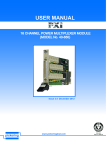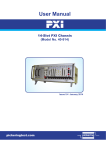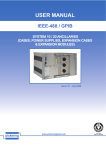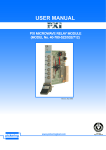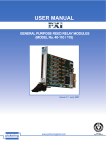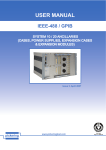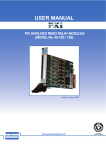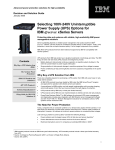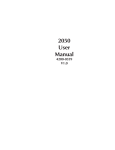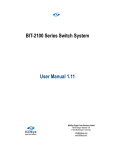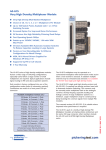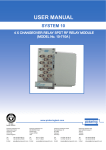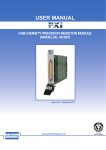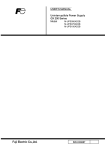Download USER MANUAL
Transcript
pickering USER MANUAL HIGH POWER RELAY MODULE (MODEL No. 40-170) Issue 3.4 December 2012 pickering www.pickeringtest.com HIGH POWER Relay Module 40-170 ISO 9002 Reg No. FM38792 Page 1 pickering © Copyright (2012) Pickering Interfaces. All Rights Reserved. No part of this publication may be reproduced, transmitted, transcribed, translated or stored in any form, or by any means without the written permission of Pickering Interfaces. Technical details contained within this publication are subject to change without notice. Page ii HIGH POWER Relay Module 40-170 pickering TECHNICAL SUPPORT For Technical Support please contact Pickering Interfaces either by phone, fax, the website or via e-mail. WARRANTY All products manufactured by Pickering Interfaces are warranted against defective materials and workmanship for a period of two years, excluding PXI chassis, from the date of delivery to the original purchaser. Any product found to be defective within this period will, at the discretion of Pickering Interfaces be repaired or replaced. Products serviced and repaired outside of the warranty period are warranted for ninety days. Extended warranty and service are available. Please contact Pickering Interfaces by phone, fax, the website or via e-mail. ENVIRONMENTAL POLICY Pickering Interfaces operates under an environmental management system similar to ISO 14001. Pickering Interfaces strives to fulfil all relevant environmental laws and regulations and reduce wastes and releases to the environment. Pickering Interfaces aims to design and operate products in a way that protects the environment and the health and safety of its employees, customers and the public. Pickering Interfaces endeavours to develop and manufacture products that can be produced, distributed, used and recycled, or disposed of, in a safe and environmentally friendly manner. Observe the Electrical Hazard Warning detailed in Section 8. Observe the Electrostatic Sensitive Device Caution detailed in Section 8. Worldwide Technical Support and Product Information http://www.pickeringtest.com Pickering Interfaces Headquarters Stephenson Road Clacton-on-Sea CO15 4NL United Kingdom Tel: +44 (0)1255-687900 Fax: +44 (0)1255-425349 E-Mail: [email protected] Pickering Interfaces Inc. 2900 Northwest Vine Street Grants Pass Oregon 97526 USA Pickering Interfaces GmbH Johann-Karg-Straße 30 D-85540 Haar-Salmdorf Germany Pickering Interfaces AB Karl Nordströmsväg 31 432 53 Varberg Sweden Tel: +1 541 471 0700 Fax: +1 541 471 8828 E-Mail: [email protected] Tel: +49 89 125 953 160 Fax: +49 89 125 953 189 E-Mail: [email protected] Tel: +46 340-69 06 69 Fax: +46 340-69 06 68 E-Mail: [email protected] Pickering Interfaces Inc. (East Coast Regional Office) 67 South Bedford Street, Suite 400W Burlington, Massachusetts 01803 USA Pickering Interfaces s.r.o. Smetanova 525 ˇ Trinec 739 61 Czech Republic Pickering Interfaces SARL 6 Rue De La Mare Blanche 77186 Noisiel Marne Le Vallee France Tel: +1 781 229 5882 Fax: +1 781 272 0558 E-mail: [email protected] Tel: +42 0558 339 168 Fax: +42 0558 340 888 E-mail: [email protected] Tel +33 1 60 53 55 50 Fax +33 1 60 53 55 99 email [email protected] HIGH POWER Relay Module 40-170 Page iii pickering THIS PAGE INTENTIONALLY BLANK Page iv HIGH POWER Relay Module 40-170 pickering CONTENTS Copyright Statement........................................................... ii Technical Support and Warranty........................................ iii Contents (this page)............................................................ v Section 1 Technical Specification....................................................... 1.1 Section 2 Technical Description......................................................... 2.1 Functional Description.................................................. 2.1 Section 3 Installation............................................................................ 3.1 Hardware Installation.................................................... 3.1 Software Installation..................................................... 3.2 Section 4 Programming Guide............................................................ 4.1 Programming Options For Pickering PXI Cards........ 4.1 Module Architecture 40-170 ........................................ 4.3 Programming the Module ............................................4.4 Section 5 Connector Information........................................................ 5.1 Section 6 Trouble Shooting................................................................. 6.1 Section 7 Maintenance Information.................................................... 7.1 Software Update............................................................ 7.1 Relay Lookup Tables 40-170 .......................................7.2 Section 8 Warnings and Cautions...................................................... 8.1 HIGH POWER Relay Module 40-170 Page v pickering THIS PAGE INTENTIONALLY BLANK Page vi HIGH POWER Relay Module 40-170 Section 1 - TECHNICAL SPECIFICATION pickering SECTION 1 - TECHNICAL SPECIFICATION 40-170 High Power Relay Module HIGH POWER RELAY MODULE 40-170 ● 2 x SPST 30Amp Power Relays ● 2 x DPST 20Amp Power Relays ● Switch up to 30VDC/250VAC ● 2 Slot PXI Module ● VISA, IVI & Kernel Drivers Supplied for Windows XP/Vista/7 ● Supported by PXI or LXI Chassis ● 2 Year Warranty Model 40-170 is available either as 2 x SPST High Power Relays, suitable for switching inductive/capacitive loads up to 30A at 250VAC or as 2 x DPST switching up to 20A. Power Relay Modules are intended for switching heavy AC or DC loads or for slaving up to large external relays, contactors and solenoids. The 40-170 Power Relay Module is suitable for applications requiring switching of either AC mains voltage or DC voltage. Pickering Interfaces have a range of power switching PXI modules, available in relay, matrix or multiplexer configurations. Power Relay Type The 40-170 is fitted with electro-mechanical power relays, with silver alloy contact material. A1 DC Resistive AC Resistive C1 A2 C2 Schematic of 40-170-001 Power Module – 2 x SPST 40-170-001 (SPST) Current/Voltage Curve A1.1 AC Resistive C1.1 A1.2 C1.2 C1 C2.1 A2.2 A2 C2.2 C2 Schematic of 40-170-002 Power Module – 2 x DPST 40-170-002 (DPST) Current/Voltage Curve PXI Switch & Instrumentation Pickering Interfaces www.pickeringtest.com HIGH POWER Relay Module 40-170 ISSUE 8.1 SEP 2012 DC Resistive A1 A2.1 Page 1.1 Section 1 - TECHNICAL SPECIFICATION pickering 40-170-001(SPST)SwitchingSpecification Contact Type: Silver Alloy Cold Switching Capacity Maximum Current: Maximum Voltage: 30A 30VDC/250VAC R.M.S. Hot Switching Capacity Maximum Current: Maximum Voltage: Maximum Power:* Minimum Switching Capacity: 30A 30VDC/250VAC R.M.S. 900W/7500VA 100mA, 5VDC Maximum Standoff Voltage: Initial Path Resistance, On: Path Resistance, Off: Bandwidth (50Ω) 600VDC 100mΩ >1x108Ω 10MHz Operate Time: 30ms typical Expected Life (operations) - resistive load Mechanical Life: >1x107 (DC), >5x106 (AC) At Maximum Switch Capacity: >1x105 30VDC / 250VAC Resistive Load 40-170-001(SPST)Current/OperatingLifeCurve * For variation of maximum hot switching capacity of voltage with current refer to plot. 30VDC / 250VAC Resistive Load 40-170-002(DPST)SwitchingSpecification Contact Type: Silver Alloy Cold Switching Capacity Maximum Current: Maximum Voltage: 20A 30VDC/250VAC R.M.S. Hot Switching Capacity Maximum Current: Maximum Voltage: Maximum Power:* Minimum Switching Capacity: 20A 30VDC/250VAC R.M.S. 600W/5000VA 100mA, 5VDC Maximum Standoff Voltage: Initial Path Resistance, On: Path Resistance, Off: Bandwidth (50Ω) 600VDC 100mΩ >1x108Ω 10MHz Operate Time: 30ms typical 40-170-002(DPST)Current/OperatingLifeCurve Expected Life (operations) - resistive load Mechanical Life: >1x107 (DC), >5x106 (AC) At Maximum Switch Capacity: >1x105 * For variation of maximum hot switching capacity of voltage with current refer to plot. PowerRequirements +3.3V +5V +12V -12V 0 200mA 340mA 0 Product Order Codes 2 x SPST 30A Power Relays 2 x DPST 20A Power Relays 40-170-001 40-170-002 Mating Connectors & Cabling For connection accessories for the 40-170 please refer to the 90-012D8-way power D-type Connector Accessories data sheet where a complete list and documentation can be found for accessories, or refer to the Connections Solutions catalog. MechanicalCharacteristics Double slot 3U PXI (CompactPCI card). Module weight: 400g (40-170-001) 420g (40-170-002) 3D models for all versions in a variety of popular file formats are available on request. Connectors PXI bus via 32 bit P1/J1 backplane connector. Signals via a front panel high power 8-way male D-Type. SideViewOf40-170PowerRelayModule Pickering Interfaces are sponsor members of the PXI Systems Alliance www.pxisa.org Page 1.2 www.pickeringtest.com E-Mail [email protected] HIGH POWER Relay Module 40-170 Section 1 - TECHNICAL SPECIFICATION pickering Programming Pickering provide kernel, IVI and VISA (NI and Agilent) drivers which are compatible with Windows XP/Vista and Windows 7 operating systems. The VISA driver is also compatible with Real-Time Operating Systems such as LabVIEW RT. For other RTOS support contact Pickering. These drivers may be used with a variety of programming environments and applications including: National Instruments products (LabVIEW, LabWindows/ CVI, Switch Executive, MAX, TestStand, etc.) Microsoft Visual Studio products (Visual Basic, Visual C+) Agilent VEE Mathworks Matlab Geotest ATE Easy MTQ Testsolutions Tecap Drivers for popular Linux distributions are available, other environments are also supported, please contact Pickering with specific enquiries. PXI & CompactPCI Compliance The module is compliant with the PXI Specification 2.2. Local Bus, Trigger Bus and Star Trigger are not implemented. Uses 33MHz 32-bit backplane interface. Safety & CE Compliance All modules are fully CE compliant and meet applicable EU directives: Low-voltage safety EN61010-1:2001, EMC Immunity EN61000-6-1:2001, Emissions EN55011:1998. PXI & LXI Chassis Compatibility Compatible with all chassis conforming to the 3U PXI and 3U cPCI specification. Compatible with Legacy and Hybrid peripheral slots in a 3U PXI Express chassis. Compatible with Pickering Interfaces LXI Modular Switching chassis. For information on driving your switching solution in an LXI environment refer to the LXI Product Guide. Operating/Storage Conditions Operating Conditions Operating Temperature: Humidity: Altitude: 0°C to +55°C Up to 90% non-condensing 5000m Storage and Transport Conditions Storage Temperature: -20°C to +75°C Humidity: Up to 90% non-condensing 15000m Altitude: Please refer to the Pickering Interfaces “Connection Solutions” catalog for the full list of connector/cabling options, including drawings, photos and specifications. This is available in either print or as a download. Alternatively our web site has dynamically linked connector/ cabling options, including pricing, for all Pickering PXI modules. Latest Details Please refer to our Web Site for Latest Product Details. www.pickeringtest.com Refer to the “PXI Product Guide” for descriptions of Pickering Interfaces’ comprehensive range of PXI switching and instrumentation modules, including specifications and product selection guides. The Product Guide is available on request or can be downloaded from the Pickering website. The “PXI Module Map” - a simple foldout selection guide to all Pickering’s 500+ PXI Modules. Ever wondered what PXI is all about? Pickering Interfaces’ “PXImate” Explains the basics of PXI and provides useful data for engineers working on switch based test systems. The PXImate is available free on request from the Pickering website. “The Big PXI Catalog” gives full details of Pickering’s entire range of PXI switch modules, instrument modules and support products. At over 500 pages, the Big PXI Catalog is available on request or can be downloaded from the Pickering website. PXI Switch & Instrumentation Pickering Interfaces HIGH POWER Relay www.pickeringtest.com Module 40-170 Page 1.3 Section 1 - TECHNICAL SPECIFICATION THIS PAGE INTENTIONALLY BLANK Page 1.4 HIGH POWER Relay Module 40-170 pickering Section 2 - TECHNICAL DESCRIPTION pickering SECTION 2 - TECHNICAL DESCRIPTION Functional Description A functional block diagram is provided in Figure 2.1. The Power Relay Module is powered by +12V and +5V inputs via Compact PCI connector J1. The interface to the user test equipment is via the front panel mounted 8 pole D-Type connector. The module comprises a PCB which provides mounting for control logic and two high power relays RL1 and RL2. Relay RL1 is energised via control signals from relay driver U13. Relay RL2 is energised via control signals from relay driver U12. Relay drivers U12 and U13 are interfaced to the low power digital control logic via sink drivers U9 and U10 respectively. The relay drivers are addressed by PCI bridge U1 to output the required signal. PCI Bridge U1 is configured by EEPROM U2. At start up the application of the +12V supply to the relays is delayed by a protection circuit comprising transistors Q1 and Q2. COMPACT PCI BUS CONNECTOR J1 MODULE CONFIGURATION U5, U6 AND U7 TERMINATING RESISTORS R4 TO R15 FRONT PANEL CONNECTOR PCI BRIDGE U1 RL1 RELAY DRIVER U13 SINK DRIVER U10 +12V PROTECTION CIRCUIT Q1, Q2 FS1 +5V 0V RL2 RELAY DRIVER U12 SINK DRIVER U9 PCI BRIDGE CONFIGURATION U2 Figure 2.1 - High Power Relay Module 40-170: Functional Block Diagram HIGH POWER Relay Module 40-170 Page 2.1 Section 2 - TECHNICAL DESCRIPTION THIS PAGE INTENTIONALLY BLANK Page 2.2 HIGH POWER Relay Module 40-170 pickering Section 3 - INSTALLATION pickering SECTION 3 - INSTALLATION Hardware Installation CAUTION Electrostatic discharge can damage the components on the module. To avoid such damage in handling the board, touch the anti-static bag to a metal part of the chassis before removing the board from the bag. Ensure that there is adequate ventilation in accordance with the PXI Specification. The module should be installed in accordance with the following procedure: 1. Ensure that the system is turned OFF but still connected to mains so that it remains grounded. 2. Choose an appropriate slot in the rack. 3. Remove the blanking plate for the chosen slot. 4. Ensure that the injector/ejector handle is in its downward position. Align the module with the card guides on the top and bottom of the slot. WARNING: Do not raise the injector/ejector handle whilst inserting the module. The module will not insert properly unless the handle is in its downward position. 5. Hold the handle whilst slowly sliding the module into the card guides until the handle catches on the injector/ ejector rail (refer to Figure 3.1). 6. Raise the injector/ejector handle until the module firmly seats into the backplane. The front panel of the module should be flush with the front panel of the chassis. 7. Screw the front panel of the module to the front panel mounting rail. 8. In a system employing MXI-3 to connect a desktop PC to a PXI chassis or to link multiple chassis, power-up the system as follows: a. For a system comprising a PC and one chassis, power up the chassis before powering up the PC. b. For a system comprising more than one chassis, turn ON the last chassis in the system followed by the penultimate, etc, and finally turn ON the PC or chassis containing the system controller. 9. For Pickering Interfaces modular LXI installation there is no requirement to use any particular power up sequence. PXI / LXI Chassis Figure 3.1 - Installing the module into a PXI / cPCI / LXI Chassis HIGH POWER Relay Module 40-170 Page 3.1 Section 3 - INSTALLATION pickering Software Installation First install the appropriate Pickering PXI switch card drivers by running the installer program Setup.exe, either from the CD-ROM supplied, or by downloading the latest version from our website http://www.pickeringtest.com - the recommended method. There are different versions of the Setup program to suit different Windows versions and software environments. Setup is accompanied by a ReadMe file containing additional installation information. A single installation covers all cards in the System 40, System 45 and System 50 ranges. When installation completes, the installed drivers’ ReadMe file is offered for display. It can also be displayed later using a shortcut on the Programs>>Pickering menu. If you are not a LabVIEW user you should choose the “full” version, and once that has been installed run the LabVIEW Runtime Engine installer via the shortcut on the Programs>>Pickering menu. In the absence of LabVIEW the Runtime Engine is required to support the Pickering Test Panels application. Page 3.2 HIGH POWER Relay Module 40-170 Section 4 - PROGRAMMING GUIDE pickering SECTION 4 - PROGRAMMING GUIDE Programming options for Pickering Interfaces PXI Cards Software drivers are supplied for Microsoft Windows XP/Vista/7 operating systems, with specific support for the following development environments: ●● ●● ●● ●● Microsoft Visual Studio (VB, C++, C#) Borland C++ National Instruments LabWindows/CVI National Instruments LabVIEW and LabVIEW RT Windows drivers are supplied in the form of Dynamic Link Libraries, which should also be usable in any other development environment that supports them. Some recent drivers developed for the LXI platform are capable of addressing both PXI and LXI domains. Such duality may be of help to users considering future migration from PXI based systems to LXI based systems, or indeed systems containing both PXI and LXI components. Programming for PXI A number of different Windows drivers are available to meet particular system requirements, and should none of these be suitable there is also the option of register-level programming. Drivers are generally ‘universal’, handling all models in the System 40, 45 and 50 ranges; however some models that are not compliant with the Ivi Swtch class cannot be used with the pi40iv IVI driver. The pipx40 and Pilpxi drivers are also applicable to certain models in the System 41 (PXI Instruments) range - see these drivers’ System 41 support list. Please note that this documentation is available in its most up-to-date form as HTML help files, fully hyperlinked for easy access - both pipx40 and Pilpxi documents are included in the Pipx40vpp software installation. IVI Driver for Windows - pi40iv The pi40iv IVI (Interchangeable Virtual Instrument) driver supports all Pickering Interfaces PXI switch cards that are consistent with the Iviswtch class model - as are the great majority of cards in the System 40/45/50 ranges. It integrates well with LabWindows/CVI and LabVIEW, and is fully compatible with Switch Executive. It is also usable in general-purpose programming environments such as Visual C++ and Visual Basic. Prior installation of the VISA and IviEngine from National Instruments are required for the correct installation and operation of this driver. VISA Driver for Windows - pipx40 The pipx40 driver conforms to the VISA (Virtual Instrument Software Architecture) standard for programmable instrumentation. Instrument control environments such as LabVIEW and LabWindows/CVI are based on VISA, and pipx40 support libraries are provided for them. Prior installation of VISA from National Instruments is required for the operation of this driver. Where VISA is available, pipx40 can also be used in general-purpose programming environments such as Visual C++ and Visual Basic. When IVI is not a system requirement this driver will often yield faster operation than the pi40iv driver. Direct I/ODriver for Windows - Pilpxi The Pilpxi driver accesses cards directly, without using the VISA software layer, while offering similar overall functionality to pipx40. It is most commonly used in general-purpose programming environments such as Visual C++ and Visual Basic. Operating speed of the VISA and Direct I/O drivers is generally comparable. HIGH POWER Relay Module 40-170 Page 4.1 Section 4 - PROGRAMMING GUIDE pickering Register-level Programming Where the supplied drivers are not suitable, register-level programming can be employed - for example: ●● ●● ●● ●● If the functionality of the supplied drivers does not meet the application requirements If security considerations demand full source-code for the application In development environments that have alternate mechanisms for accessing PCI bus For operating systems other than Windows Programming for LXI When Pickering PXI cards are inserted into an LXI Modular Chassis a different set of drivers is available. IVI Driver for Windows - pi40iv The pi40iv IVI also supports LXI inserted cards simply by changing the resource string to address string to the appropriate address. Direct I/ODriver for Windows - Piplx The piplx driver is based on the PXI Direct IO driver pilpxi, but with added functionality to deal with the added need to address the chassis using an IP address. It integrates well with LabWindows/CVI and LabVIEW, and is fully compatible with Switch Executive. It is also usable in general-purpose programming environments such as Visual C++ and Visual Basic. Please note that this driver may also be used in the PXI domain. If the addressed card is in the local computer PCI/ PXI system, commands will be passed through to the PXI Direct IO driver. This mechanism allows the piplx driver to be used for both PXI and LXI cards. The LXI format offers additional interface options not available in PXI : .NET A .NET native driver is also available. Once again this may be used for both LXI and PXI card control. SOAP Pickering LXI products include a SOAP interface which is usable from a wide variety of platforms and languages. SSH Pickering LXI products include an SSH interface which allows remote command line access to control cards, or, using a suitable package, programmatic control. The user is advised to visit the Pickering web site for further details of all the above drivers, where documentation, example programs, and further help with driver choice are available. LabVIEW, LabWindows/CVI and Switch Executive are trademarks of National Instruments Corporation. General Pickering Card Architecture With most drivers, before programming a Pickering card it is important to understand the basic architecture of Pickering cards. The switches on a Pickering card are organized into logical sub-units, each sub-unit containing a set of objects of similar type and use. These objects may be switches, digital outputs, digital inputs, resistors, power supplies etc, depending on the nature of the specific card. For example a simple matrix card will usually contain a single sub-unit containing the switches arranged in a 2-dimensional array. However a similar card with additional isolating relays connected to the matrix will contain additional sub-units containing those isolation relays. Low level drivers include functions to allow the programmer to query the card to ascertain the number of sub-units, and the size and type of each sub-unit. For full details of the driver functions available the programmer should refer to the documentation provided. Page 4.2 HIGH POWER Relay Module 40-170 Section 4 - PROGRAMMING GUIDE pickering MODULE Architecture - 40-170 The 40-170 High Power Relay Module is available with 2 x SPST or 2 x DPST Normally Open Power relays. Energising a particular relay creates a signal path between the C and A terminals. The relay module’s switching architectures are shown in their default state in the diagrams below: A1.1 C1.1 A1.2 C1.2 A1 C1 A2.1 C2.1 A2 C2 A2.2 C2.2 40-170-001 (2 x SPST) 40-170-002 (2 x DPST) One sub-unit is used to control all the module’s relays as shown below. Enabling a particular bit closes the C to A signal path. Sub-Unit Bit 40-170-001 Signal Path (with relay energised) 40-170-002 Signal Path (with relay energised) 1 1 C1 to A1 C1.1 to A1.1 and C1.2 to A1.2 1 2 C2 to A2 C2.1 to A2.1 and C2.2 to A2.2 HIGH POWER Relay Module 40-170 Page 4.3 Section 4 - PROGRAMMING GUIDE pickering Programming The MODULE Here are examples of using the drivers with the 40-170 module. Using PILPXI To operate a relay the user could use the simple OpBit command or the WriteSub commands OpBit DWORD sub_unit = 1; PIL_OpBit( card_num, sub_unit, 1, 1); PIL_OpBit( card_num, sub_unit, 1, 0); PIL_OpBit( card_num, sub_unit, 2, 1); // Operates the A1/C1 relay // Releases the A1/C1 relay // Operates the A2/C2 relay WriteSub // Sub-unit is 2 bits wide, so 1 DWORD is needed to hold the pattern DWORD data[1]; data[0] = 1; // Sets lowest bit to 1, A1/C1 relay PIL_WriteSub( card_num, sub_unit, data); data[0] = 0x2; // Sets 2nd bit, A2/C2 relay // All other relays are set to off PIL_WriteSub( card_num, sub_unit, data); Using PIPX40 setChannelState ViUInt32 sub_unit = 1; pipx40_setChannelState(vi, sub_unit, 1, VI_ON); pipx40_setChannelState(vi, sub_unit, 1, VI_OFF); pipx40_setChannelState(vi, sub_unit, 2, VI_ON); // Operates the A1/C1 relay // Releases the A1/C1 relay // Operates the A2/C2 relay setChannelPattern // Sub-unit is 2 bits wide, so 1 ViUInt32 value is needed to hold the entire pattern ViUInt32 data[1]; data[0] = 1; // Sets lowest bit to 1, A1/C1 relay pipx40_setChannelPattern( vi, sub_unit, data); data[0] = 0x2; // Sets 2nd bit, A2/C2 relay // All other relays are set to off pipx40_setChannelPattern( vi, sub_unit, data); Using pi40iv The IVI driver has no special labelling for this card and treats the array of switches as a simple array, labelling the channels using the normal com./ch labelling tags. pi40iv_Connect(vi, com1, ch1); // Operates the A1/C1 relay pi40iv_Disconnect(vi, com1, ch1); // Releases the A1/C1 relay pi40iv_Connect(vi, com2, ch2); // Operates the A2/C2 relay The IVI Swtch driver specification contains no bulk setting capabilities. Page 4.4 HIGH POWER Relay Module 40-170 Section 5 - CONNECTOR INFORMATION pickering SECTION 5 - CONNECTOR INFORMATION A1 A1 (RELAY 1, PIN 1) A2 C1 (RELAY 1, PIN 4) A3 A1 C1 A4 A2 C2 A5 A2 (RELAY 2, PIN 1) A6 C2 (RELAY 2, PIN 4) 2 x SPST A7 A8 Figure 5.1 - Pin Outs: 2xSPDT Power Relay 30A Module 40-170-001 (8-way D Plug) HIGH POWER Relay Module 40-170 Page 5.1 Section 5 - CONNECTOR INFORMATION pickering A1 A1.1 (RELAY 1, PIN 1) A2 C1.1 (RELAY 1, PIN 2) A1.1 C1.1 A3 A1.2 (RELAY 1, PIN 3) A1.2 C1.2 A4 C1.2 (RELAY 1, PIN 4) A2.1 C2.1 A5 A2.1 (RELAY 2, PIN 1) A6 C2.1 (RELAY 2, PIN 2) A7 A2.2 (RELAY 1, PIN 3) A8 C2.2 (RELAY 1, PIN 4) A2.2 C2.2 4 x DPST Figure 5.2 - Pin Outs: 2xDPST Power Relay 20A Module 40-170-002 (8-way D Plug) Page 5.2 HIGH POWER Relay Module 40-170 SECTION 6 - TROUBLE SHOOTING pickering SECTION 6 - TROUBLESHOOTING Installation Problems The Plug & Play functionality of Pickering switch cards generally ensures trouble-free installation. If you do experience any installation problems you should first ensure that all cards are properly seated in their slots. Improperly mated cards may go undetected by the operating system, or may be detected as a card of an unknown type. They can also cause the computer to freeze at various stages in the boot sequence. If your system employs MXI-3 you should check the integrity of all MXI-3 links. When the system is powered up, and during Windows start-up, you should expect to see periodic activity on the MXI-3 RX/TX (yellow) indicators, clearing to leave only the PWR/LNK (green) LEDs illuminated. The RX/TX indicators should show activity when you attempt to access a card. Diagnostic Utility The Pickering Diagnostic Utility (accessible through the Programs>>Pickering>>PXI Utilities menu) generates a diagnostic report of the system’s PCI configuration, highlighting any potential configuration problems. Specific details of all installed Pickering switch cards are included. All the installed Pickering switch cards should be listed in the “Pilpxi information” section - if one or more cards is missing it may be possible to determine the reason by referring to the PCI configuration dump contained in the report, but interpretation of this information is far from straightforward, and the best course is to contact Pickering support: [email protected], if possible including a copy of the diagnostic report. In the “VISA information” section, if VISA is not installed it’s absence will be reported. This does not affect operation using the Direct I/O driver, and is not a problem unless you wish to use VISA. VISA is a component of National Instruments LabWindows/CVI and LabVIEW, or is available as a standalone environment. If VISA is present and is of a sufficiently recent version, the section “Pipx40 information” should present a listing similar to “Pilpxi information”. Please note that the Diagnostic Utility cannot access cards if they are currently opened by some other application, such as the Test Panels or Terminal Monitor. HIGH POWER Relay Module 40-170 Page 6.1 SECTION 6 - TROUBLE SHOOTING THIS PAGE INTENTIONALLY BLANK Page 6.2 HIGH POWER Relay Module 40-170 pickering Section 7 - MAINTENANCE INFORMATION pickering SECTION 7 - MAINTENANCE INFORMATION SOFTWARE UPDATE For PXI modules operating in a PXI chassis, no module software updates are required. For the latest version of the driver please refer to our web site www.pickeringtest.com where links to our Software Download page will provide the latest version of the driver software for the various programming environments encountered. For PXI modules which are supported in one of Pickering Interfaces’ Modular LXI Chassis (such as the 60-102 and 60-103) no module software update is required. If the module was introduced after the LXI chassis was manufactured the module may not be recognized, in this case the chassis firmware may need upgrading. This is a simple process which is described in the manual for the Modular LXI Chassis. RELAY LOOK-UP TABLES The following pages provide a cross reference between the signal paths of the Reed Relay Module and the physical relays on the PCB. The tables can be used in the fault finding process and should be used in conjunction with the corresponding PCB layout diagrams to identify the position of faulty relays. Figure 7.1 - 40-170 High Power Relay Module HIGH POWER Relay Module 40-170 Page 7.1 Section 7 - MAINTENANCE INFORMATION pickering Table 7.1 - High Power Relay Module 40-170-001: Relay Numbering Signal Path (with relay energised) Relay No. 40-170-001 C1 to A1 RL1 C2 to A2 rl2 RL1 RL2 C10 C2 R4 C7 R16 C29 Q2 R17 Q1 R18 R1 U2 U9 R2 C22 U8 U12 U11 C16 C15 C30 R5 R6 R7 R8 LK1 LK4 U4 C28 C23 C17 C9 R9 U1 C6 R10 R11 R12 LK2 LK5 C31 U3 U13 C18 R13 R14 C5 LK3 LK6 U7 C25 U10 C20 R3 C24 U6 C27 U5 C32 C19 C26 C21 C7 R15 C13 C14 C12 C11 FS1 C4 C3 C1 Figure 7.2 - 40-170 High Power Relay Module Component Layout Table 7.2 - High Power Relay Module 40-170-002: Relay Numbering Page 7.2 Signal Path (with relay energised) Relay No. 40-170-002 C1.1 to A1.1 and C1.2 to A1.2 RL1 C2.1 to A2.1 and C2.2 to A2.2 rl2 HIGH POWER Relay Module 40-170 J1 Section 8 - CAUTIONS pickering SECTION 8 - WARNINGS AND CAUTIONS Warning – Hazardous Environments This product is not specifically designed for use in hazardous environments, for example in explosive atmospheres. If the product is to be used in hazardous environments we recommend that the user ensures suitable protective measures are taken. WARNING - DANGER OF ELECTRIC SHOCK THIS MODULE MAY CONTAIN HAZARDOUS VOLTAGES. BEFORE REMOVING THE MODULE FROM THE RACK REMOVE ALL SUPPLIES. CAUTION – Handling of Electrostatic-Sensitive Semiconductor Devices Certain semiconductor devices used in this equipment are liable to damage due to static voltage. Observe the following precautions when handling these devices in their unterminated state, or sub-units containing these devices: 1. Persons removing sub-units from an equipment using these devices must be earthed by a wrist strap and a resistor at the point provided on the equipment. 2. Soldering irons used during the repair operations must be low voltage types with earthed tips and isolated from the mains voltage by a double insulated transformer. 3. Outer clothing worn must be unable to generate static charges. 4. Printed Circuit Boards (PCBs) fitted with these devices must be stored and transported in anti-static bags. HIGH POWER Relay Module 40-170 Page 8.1 pickering THIS PAGE INTENTIONALLY BLANK Page 8.2 HIGH POWER Relay Module 40-170


























